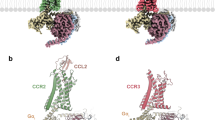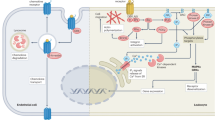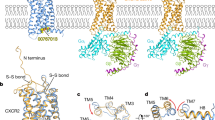Abstract
Chemokines direct the trafficking of white blood cells in immune surveillance, playing a key role in inflammatory and infectious diseases such as AIDS1–5. All chemokines studied so far are secreted proteins of relative molecular mass ∼7K–15K and fall into three families that are defined by a cysteine signature motif: CXC, CC and C (refs 3, 6, 7), where C is a cysteine and X any amino-acid residue. We report here the identification and characterization of a fourth human chemokine type, derived from non-haemopoietic cells and bearing a new CX3C fingerprint. Unlike other chemokine types, the polypeptide chain of the human CX3C chemokine is predicted to be part of a 373-aminoacid protein that carries the chemokine domain on top of an extended mucin-like stalk. This molecule can exist in two forms: either membrane-anchored or as a shed 95K glycoprotein. The soluble CX3C chemokine has potent chemoattractant activity for T cells and monocytes, and the cell-surface-bound protein, which is induced on activated primary endothelial cells, promotes strong adhesion of those leukocytes. The structure, biochemical features, tissue distribution and chromosomal localization of CX3C chemokine all indicate that it represents a unique class of chemokine that may constitute part of the molecular control of leukocyte traffic at the endothelium.
This is a preview of subscription content, access via your institution
Access options
Subscribe to this journal
Receive 51 print issues and online access
$199.00 per year
only $3.90 per issue
Buy this article
- Purchase on SpringerLink
- Instant access to full article PDF
Prices may be subject to local taxes which are calculated during checkout
Similar content being viewed by others
References
Strieter, R. M. et al. J. Immunol. 156, 3583–3586 (1996).
Baggiolini, M. & Dahinden, C. A. Immunol. Today 104, 27–29 (1994).
Schall, T. J. & Bacon, K. B. Curr. Opin. Immunol. 6, 865–873 (1994).
Weiss, R. A. & Clapham, P. R. Nature 381, 647–648 (1996).
Pemack, B. P. & Schall, T. J. Nature Med. 2, 1174–1178 (1996).
Clore, G. M. & Gronenborn, A. M. FASEB J. 9, 57–62 (1995).
Wells, T. N. et al. J. Leuk. Biol. 59, 53–60 (1996).
Altschul, S. F., Boguski, M. S., Gish, W. & Wootton, J. C. Nature Genet. 6, 119–129 (1994).
Kelner, G. S. et al. Science 266, 1395–1399 (1994).
Lennon, G., Auffray, C., Polymeropoulos, M. & Soares, M. B. Genomics 33, 151–152 (1996).
Gendler, S. J. & Spicer, A. P. Annu. Rev. Physiol. 57, 607–634 (1995).
Hansen, J. E. et al. Biochem. J. 308, 601–813 (1995).
Shimizu, Y. & Shaw, S. Nature 366, 630–631 (1993).
Bernfield, M. et al. Annu. Rev. Cell. Biol. 8, 365–393 (1992).
Vyas, P., Vickers, M. A., Picketts, D. J. & Higgs, D. R. Genomics 29, 679–689 (1995).
Springer, T. A. Cell 76, 301–314 (1994).
Lasky, L. A. Science 258, 964–969 (1992).
Butcher, E. C. & Picker, L. J. Science 272, 60–66 (1996).
Webb, L. M. C., Ehrengruber, M. U., Clark-Lewis, I., Baggiolini, M. & Rot, A. Proc. Natl Acad. Sci. USA 90, 7158–7162 (1993).
Tanaka, Y., Adams, D. H. & Shaw, S. Immunol. Today 361, 79–82 (1993).
Witt, D. P. & Lander, A. D. Curr. Biol. 4, 394–400 (1994).
Schall, T. J., Bacon, K., Toy, K. J. & Goeddel, D. V. Nature 347, 669–671 (1990).
Dawson, P. E., Muir, T. W., Clark-Lewis, I. & Kent, S. B. Science 266, 776–779 (1994).
Author information
Authors and Affiliations
Rights and permissions
About this article
Cite this article
Bazan, J., Bacon, K., Hardiman, G. et al. A new class of membrane-bound chemokine with a CX3C motif. Nature 385, 640–644 (1997). https://doi.org/10.1038/385640a0
Received:
Accepted:
Issue Date:
DOI: https://doi.org/10.1038/385640a0



